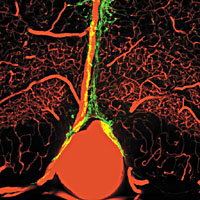
Abnormalities in a serotonin- containing neuron, such as the one pictured above, may be responsible for sudden infant death syndrome, researchers say. |
role in SIDS, study suggests
Neurons thought to play a key role in sudden infant death syndrome (SIDS) are located near some of the largest arteries in the brain, according to a study by a School of Medicine research team published in the journal Nature Neuroscience.
The senior investigator -- Dr. George Richerson, associate professor of neurology and physiology -- said his team's findings support a new theory that infants who succumb to SIDS have developmental abnormalities in these neurons. In healthy infants and adults, the response of these neurons to low carbon dioxide levels during sleep may alert them to wake and breathe deeply.
"When someone falls asleep with their face in a pillow, carbon dioxide levels rise," Richerson says. "The normal response is to wake up slightly, turn the head and breathe harder. There is evidence that some infants that die of SIDS lack this normal protective response."
SIDS is the unexpected and sudden death of an apparently healthy infant during sleep. It is the leading cause of death in infants between two weeks and one year of age, striking about one per 1,000 infants. The cause is unknown, but certain risk factors have been identified, among them: lying face downward, prematurity, low birth-weight, male sex, winter months and recent mild upper respiratory infection. A leading theory is that SIDS is a problem with breathing during sleep.
Breathing is dependent on normal levels of carbon dioxide, which is monitored by neurons in the brain called central chemoreceptors. Richerson and his co-investigators had established in earlier research that neurons in the brain containing the chemical serotonin are strongly stimulated by an increase in carbon dioxide, indicating that they are central chemoreceptors.
Carbon dioxide is the colorless, odorless gas given off from the lungs as a waste product of respiration. If carbon dioxide levels in the blood become either too high or too low, there are severe -- even fatal -- deleterious effects. Carbon dioxide levels within the blood are controlled within the normal range by changes in the depth and rate of breathing.
In this study, using imaging and electron microscopy, the researchers were able to show in laboratory rats that serotonergic neurons are located right next to large arteries in the brain, where they are ideally situated for sensing carbon dioxide levels in arterial blood. Thus, their location is optimized for their function as chemoreceptors.
Researchers at Harvard and Dartmouth studied the brains of infants who died of SIDS and found abnormalities of serotonin-containing neurons, notes Richerson. "These are the same neurons that we have been studying in rats," he says. "We now believe that serotonin neurons play an important role in detecting a rise in carbon dioxide during sleep, and they cause arousal and increased breathing. A defect in these neurons could lead to SIDS by preventing this normal response, resulting in death from excessive carbon dioxide levels."
Richerson says he and his team are collaborating with the scientists at Harvard and Dartmouth to understand how an abnormality of serotonin neurons could cause SIDS. "The ultimate goal," he says, "is to find a way to predict which children are at greatest risk, and find ways to reduce the chance that they will suffer this devastating event."
-- By Jacqueline Weaver
T H I S
Bulletin Home
 W E E K ' S
W E E K ' S S T O R I E S
S T O R I E S![]()
 Yale creates Center for Genomics and Proteomics
Yale creates Center for Genomics and Proteomics
![]()
![]()
 NIH grant to support research on treatment of epilepsy
NIH grant to support research on treatment of epilepsy![]()
![]()
 African American Studies Department examines its history and its future
African American Studies Department examines its history and its future
![]()
![]()
 Alumnus Bryan Rigg reveals untold story of 'Hitler's Jewish Soldiers'
Alumnus Bryan Rigg reveals untold story of 'Hitler's Jewish Soldiers'![]()
![]()
 Managing editor decries 'outrageous lies' in the media
Managing editor decries 'outrageous lies' in the media![]()
![]()
 See possibilities when job searching, editor advises
See possibilities when job searching, editor advises![]()
![]()
 IN FOCUS: Resource Office on Disabilities
IN FOCUS: Resource Office on Disabilities![]()
![]()
 New website offers information on wheelchair access to campus facilities
New website offers information on wheelchair access to campus facilities![]()
![]()
 Yale Engineering forum offers perspectives . . .
Yale Engineering forum offers perspectives . . .![]()
![]()
 Abnormal neurons may play role in SIDS, study suggests
Abnormal neurons may play role in SIDS, study suggests![]()
![]()
 Stories, adventures, journeys -- festival offers them all
Stories, adventures, journeys -- festival offers them all![]()
![]()
 Restorative home care help elderly regain independence
Restorative home care help elderly regain independence![]()
![]()
 In there a nurse in the house?
In there a nurse in the house?![]()
![]()
 New Yale chapter offers support for Hispanic students
New Yale chapter offers support for Hispanic students![]()
![]()
 Study shows promising cocaine treatment is ineffective on humans
Study shows promising cocaine treatment is ineffective on humans![]()
![]()
 Update on YB&C survey
Update on YB&C survey ![]()
![]()
 Local third-graders graduate from America Reads program
Local third-graders graduate from America Reads program![]()
![]()
 Yale affiliates awarded YUWO scholarships to continue studies
Yale affiliates awarded YUWO scholarships to continue studies![]()
![]()
 Yale Books in Brief
Yale Books in Brief![]()
![]()
 Campus Notes
Campus Notes![]()
 |
| Visiting on Campus
Visiting on Campus |
| Calendar of Events
Calendar of Events |
| In the News
In the News |
| Bulletin Board
Bulletin Board![]()
Yale Scoreboard |
| Classified Ads
Classified Ads |
| Search Archives
Search Archives |
| Deadlines
Deadlines![]()
Bulletin Staff |
| Public Affairs Home
Public Affairs Home |
| News Releases
News Releases |
| E-Mail Us
E-Mail Us |
| Yale Home Page
Yale Home Page